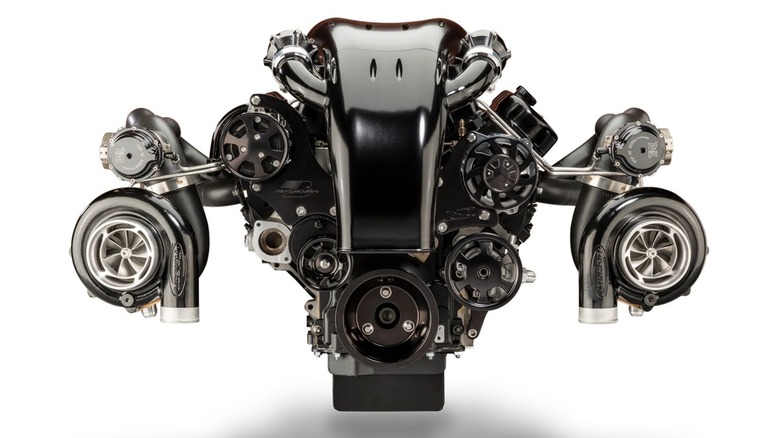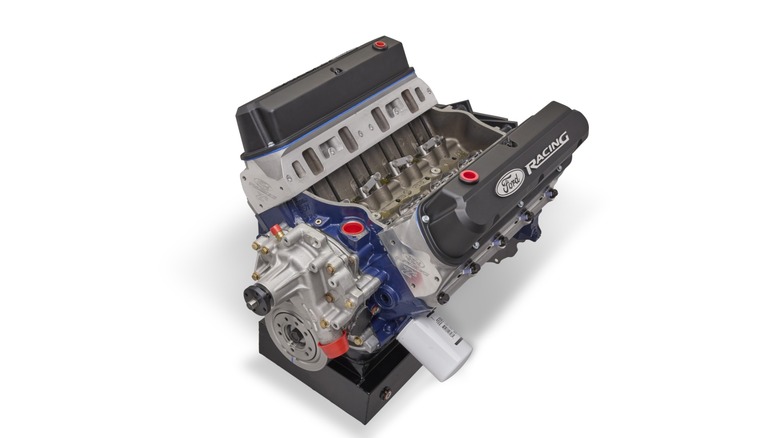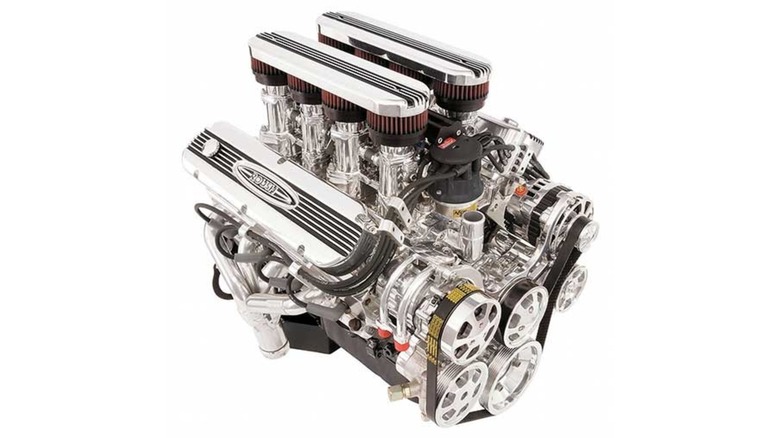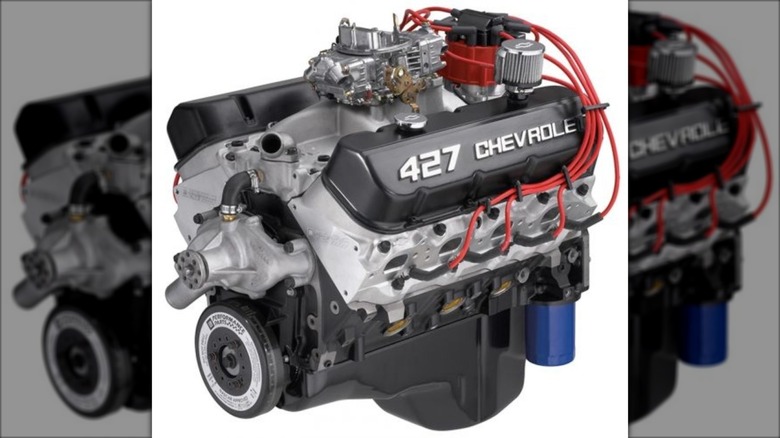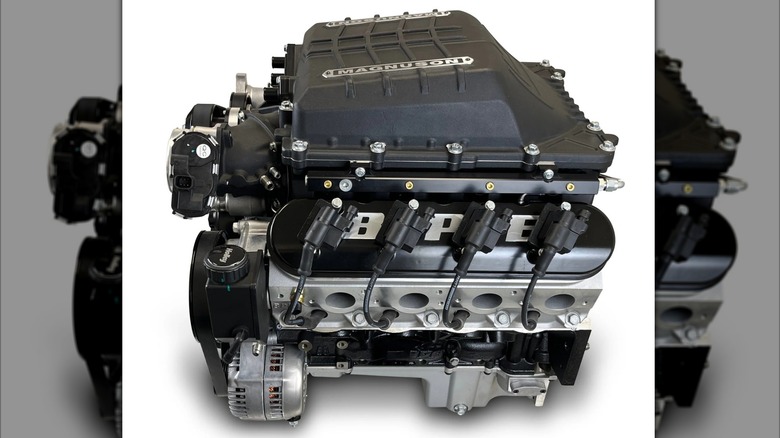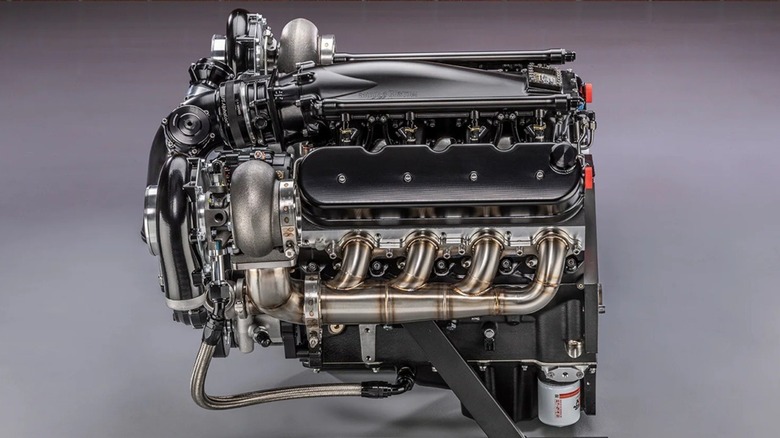5 427 Crate Engines You Can Buy That Provide Some Serious Horsepower
Over the years, the 427-cubic-inch crate engine has taken many forms. Originally, the 427 was offered as a big block engine by both Ford and Chevrolet. In the 1960s, Ford's 427 big block dominated race tracks around the world and included a single overhead cam (SOHC) version known as the "Cammer," which was banned from the NASCAR circuit in 1964. While 427-cubic-inch Ford big blocks were common, the Chevrolet 427 big block was one of the rarest Chevy engines ever.
In today's crate engine market, builders can produce 427-cubic-inch engines with serious horsepower. For this rundown of 427 crate engines, we'll look at traditional big-block engines as well as some modern small-block units. Some will be naturally aspirated, while others will use forced air induction from superchargers and turbos. These 427 crate engines will come from various sources, including Chevrolet and Ford, as well as a few custom engine builders with engines producing 480 horsepower at the low end all the way up to 2,000 horsepower at the highest.
Ford's 535-horsepower 427 Boss crate engine
Ford began producing the FE-series of big block V8 engines in 1958. The FE design was available in multiple displacements, including 360, 390, and 427 cubic inches. In addition to the 427 Cammer, Ford built another version of the 427 big-block V8, nicknamed the Side-Oiler, for endurance racing — more precisely, to compete with Ferrari and win. The Ford 427 FE is no longer in production, but the 427-cubic-inch Boss crate engine, derived from the Ford 351 small block, carries on the company's racing spirit and provides some serious horsepower.
Ford Performance uses "535 HP" in the 427-cubic-inch Boss crate engine's product name, but the engine specs provided indicate a power output up to 543 horsepower at 5,900 rpm and 540 lb-ft of torque at 4,800 rpm. The crate engine's construction includes an assortment of forged internals such as the steel crankshaft, steel H-beam connecting rods, and aluminum pistons. The aluminum cylinder heads contain intake valves measuring 2.05 inches in diameter and 1.60-inch exhaust valves. The included hydraulic roller camshaft provides up to 0.618 inches of lift with up to 248 degrees of duration.
The 427 Boss Crate Engine is available in long block form and includes components like the valve covers, front sump oil pan, and water pump. The crate engine does not include a flywheel, distributor system, or intake manifold. Ford recommends an Edelbrock Super Victor intake manifold and a 770-cfm carburetor to achieve the advertised power ratings.
Roush Performance's Ford 427 crate engines
Roush Performance offers three small-block Ford-based 427-cubic-inch V8 crate engines that produce over 500 horsepower. The 427 SR crate engine provides 510 horsepower, the 427 R has 550 horsepower, and the 427 IR delivers 560 horsepower and 540 lb-ft of torque using premium fuel.
The Roush 427 IR features a cast-iron engine block with four-bolt main bearing caps, a 9.5-inch deck height, and CNC-ported aluminum cylinder heads. The rotating assembly consists of a steel crankshaft, steel H-beam connecting rods, and forged aluminum pistons. The valve train assembly consists of a hydraulic roller camshaft with undisclosed lift and duration that Roush points out will have a rougher idle than normal. The aluminum "8-stack" intake manifold is among the Roush 427 IR crate engine's most striking features.
Unlike the Ford Performance 427 Boss crate engine above, the Roush 427 IR is delivered as a complete and turn-key crate engine. It's also protected by a two-year or 24,000-mile warranty. However, those interested in purchasing a Roush 427 IR crate engine should understand that these high-performance engines have characteristics that differ from traditional production engines. Some of these, which are not covered by the warranty, include: excess mechanical noise, increased heat generation, and higher oil and fuel consumption. They also may not be street legal, depending on the configuration.
GM Performance's 480-horsepower big-block 427
The second-generation Chevy 427 debuted in 1966, but it's most fondly remembered as the engine that powered the 1967 Chevrolet Corvette Convertible. It used smaller diameter cylinders and a longer stroke than the first-gen model to achieve its displacement. While the L88 427 was capable of producing upwards of 600 horsepower, published specs at the time rated it at a mere 435 hp.
While the Chevy big block largely disappeared from production in the 1970s, other than in a few heavy-duty pickups and luxury sports cars, Chevrolet still offers a modernized version of its L88 for sale through GM Performance. Part of Chevrolet's big block engine family, the ZZ427/480 HP crate engine produces 480 horsepower at 6,000 rpm and 490 lb-ft of torque at 3,800 rpm with a maximum recommended rpm of 6,400. As you'd expect, the big block 427 Chevy features a full complement of forged internals in addition to its dual-plane intake manifold, 770-cfm carburetor, and hydraulic roller camshaft. It features oval port aluminum cylinder heads with 2.19-inch intake and 1.88-inch exhaust valves mounted to a four-bolt main cast iron engine block.
BluePrint Engines's LS small-block 427 crate engines
BluePrint Engines offers 15 versions of its LS-compatible 427-cubic-inch crate engine, with power ratings starting at 540 horsepower. Naturally-aspirated models top out at 605 horsepower while supercharged versions deliver 800 horsepower.
The top-line BluePrint Engines 427 crate engine is the Pro Series engine fitted with a black pulley kit and a Holley Terminator X EFI system. The Pro Series 427 delivers 605 horsepower and 565 lb-ft of torque. The engine is built upon a BluePrint Engines LSX-style cast iron block that features "thicker decks, reinforced webbing, and extended cylinder skirts for added durability."
Mounted to the block are a pair of BluePrint Engines LS3 aluminum cylinder heads with 69cc combustion chambers. Intake valves measure 2.165 inches while exhaust valve diameters are 1.590 inches. Inside the block, you'll find forged goodies including the crankshaft, connecting rods, and pistons.
Need more power? Consider the similarly specced BluePrint 427 Pro Series engine with a supercharger on top. The supercharged version pumps out 800 horsepower and 780 lb-ft of torque thanks primarily to the Magnuson TVS2650 supercharger and Holley Terminator X Max EFI system.
Nelson Racing Engines has a 2,000 horsepower 427
Nelson Racing Engines (NRE) offers a variety of LS small block-derived 427-cubic-inch crate engines that provide some serious horsepower. The lowest rated of the bunch is the NRE 427 LS Naturally Aspirated, delivering a minimum of 650 horsepower. At the top of the scale sits the 2,000-horsepower Warrior Series NRE Twin-Turbo Alien LS 427, one of Nelson Racing Engines' most powerful engines. It's a crate engine built for track use, although you can occasionally drive it on the street.
While the twin-turbo Alien LS 427 is based on GM's highly-regarded LS engine, none of the parts have likely ever been inside a GM warehouse. The cast-iron engine block is a custom design from Dart Machinery. There's also the Callies Magnum crankshaft, Oliver Billet Max connecting rods, and forged JE pistons. The cylinder heads are a fully CNC-ported custom NRE design based on standard LS3 heads. Topping it all off are NRE's Alien Intake Manifold and 76-mm Mirror Image Gen 3 twin-turbocharger system.
